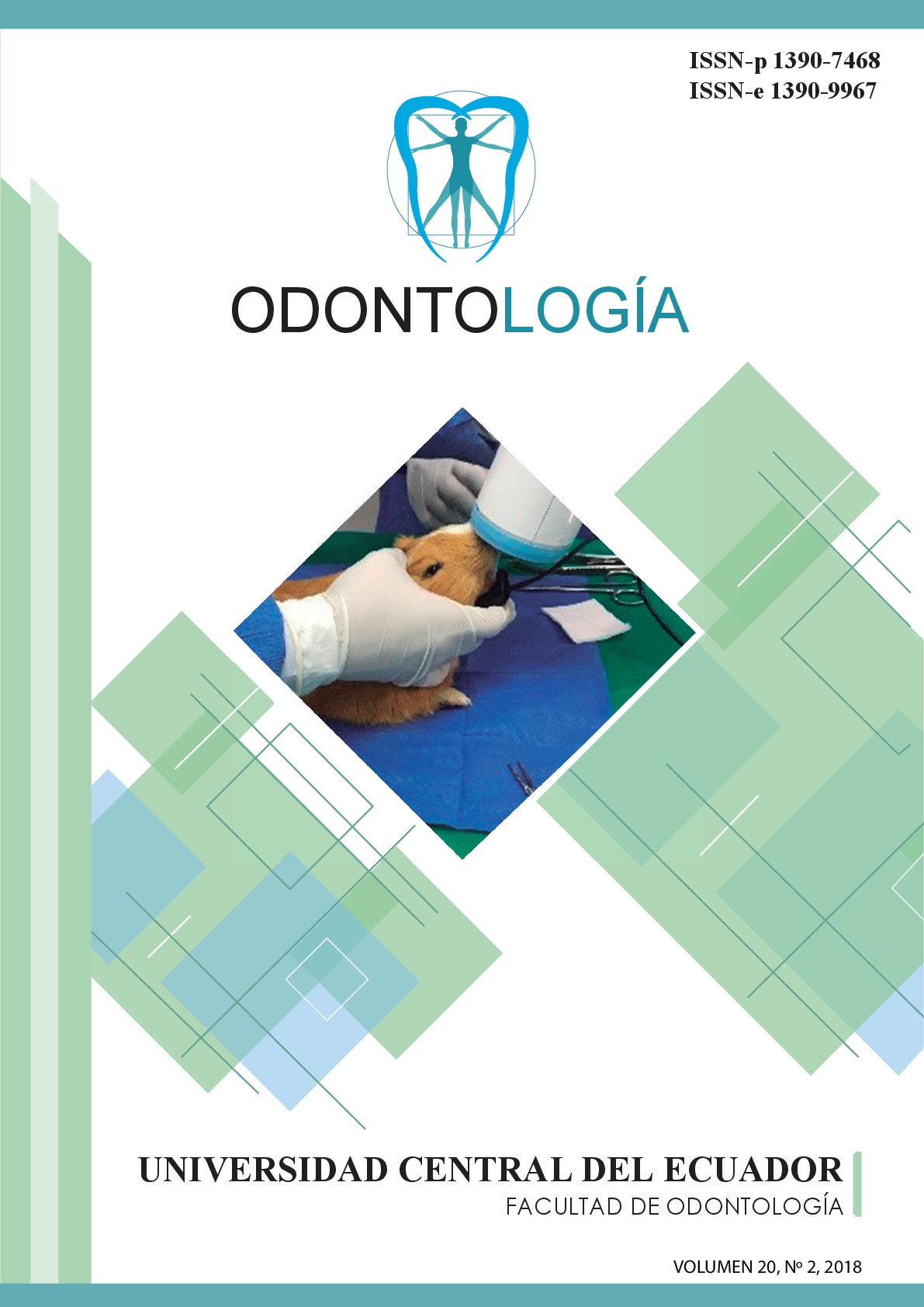Antibacterial effect of pediatric mouthwashes marketed in Ecuador on Streptococcus Mutans strains: In vitro study
Keywords:
Dental carie, Oral hygiene, Health promotion, Mouthwashes, XylitolAbstract
Dental caries is considered a public health problem, children being the most vulnerable population due to inadequate eating habits and oral hygiene. Objective: To determine and compare the antibacterial effect of pediatric mouthwashes based on Cetilpiridinium Chloride (0.075%) and Xylitol (10%), on strains of Streptococcus Mutans. Materials and Methods: In vitro experimental study, consisting of 20 strains of S. mutans obtained from the repository of the National Institute of Public Health Research (INSPI), which were planted in agar trypticase soy agar. The 60 Petri dishes (N = 60) were divided into three experimental groups (N = 20 each) of 10 mL, 15mL and 20mL for each mouthwash, in each petri dishes were placed 5 paper discs impregnated with the solution of the groups being: G1= Colgate Plax (Cetylpyridinium Chloride 0.075%), G2= Denture kids (Xylitol 10%), G3= Blendy (Xylitol 10%) C+= Positive Control (Chlorhexidine 0.12%) C-= Negative Control (Distilled Water). Petri dishes were incubated at 37° C with low oxygen pressure. After 48 hours they were observed to measure the inhibition zones. The statistical analysis of Kruskal Wallis and U Mann Whitney with a level of significance of 5% was carried out. Results: The amounts of 10, 15 and 20mL of Cetilpiridinium Chloride showed a significant increase of halo > 14mm (p = 0.001) highly sensitive. The rinses with Xylitol showed a lower inhibition halo ≥ 8mm (p = 0.1) intermediate sensitivity. The amount of 20mL of cetylpyridinium chloride did not show significant differences when compared to 15mL of Chlorhexidine (p = 1.0). Conclusions: Mouthwashes based on Xylitol showed intermediate sensitivity, its effect being lower when compared to the Cetylpyridinium chloride that was highly sensitive.
Downloads
References
OMS. Organizacion Mundial de la Salud. [Online].; 2013 [cited 2014 06 10. Available from: http://www.who.int/mediacentre/factsheets/fs317/es/.
Oropeza A, Yasmín Z. Caries dental en primeros molares permanentes de escolares de la delegación Tláhuac. ADM. 2012 Abril; LXIX(2): p. 63-69.
Ministerio de Salud Pública del Ecuador. Ministerio de Salud Pública del Ecuador. [Online]. Quito- Ecuador; 2015 [cited 2016 Abril 20. Available from: https://aplicaciones.msp.gob.ec/salud/archivosdigitales/documentosDirecciones/dnn/archivos/GPC%20Caries%20final%20%2024-12-2014.pdf.
Palomer L. Caries dental en el niño. Una enfermedad contagiosa. Chilena de Odontopediatria. 2006; 77(1): p. 56-60.
Argandoña R, Duque C, Sampaio K, Rodrigues V, Aguiar M, Colombo N, et al. Genotypic diversity and phenotypic traits of streptococcus mutans isolates and their relation to severity of early childhood caries. BMC Oral Health. 2017; 17(115): p. 1-9.
Camejo M. Sensibilidad in vitro del streptococcus mutans a sanguinarina, compuesto fenólico y clorherxidina. Revista Venezolana de Odontología. 1999; 37(2): p. 1-37.
Hurt A, Coleman N, Tuzuner T, Bagis B, Korkmas F, Nicholson J. Release of cetyl pyridinium chloride from fatty acid chelate temporari dental cement. Acta Biomater Odontol Scan. 2016; 2(1): p. 1-6.
Riley P, Moore D, Ahmed F, Sharif M, Worthington H. Xylitol-containg products for preventing dental caries in children and adults. Cochrane Database Syst Rev. 2015; 26(3): p. 1-64.
Jorgensen J, Turnidge J. Susceptibility test methods: dilution and disk diffusion methods. In Manual of Clinical Microbiology. American Society of Microbiology. 2015; 10(112): p. 1253-73.
Cercenado E, Saavedra-Lozano J. El antibiograma. Iterpretación del antibiograma : conceptos generales. An pediatr Contin. 2009; 7(4): p. 2014-7.
Ronanki S, Kulkarni S, Hemalatha R, Kumar M, Reddy P. Efficacy of comercially avaliable chlorhexidine mouthrinses against specific oral microflora. Indian J Dent Res. 2016; 27(1): p. 48-53.
Aguilera M, Romano E, Ramos N, Rojas L. Sensibilidad del Streptococcus Mutans a tres enjuagues bucales comerciales. ODOUS CIENTIFICA. 2011; 1(7): p. 7-13.
Bonecker M, Abanto J, Tello G, Oliveira I. Impact of dental caries on preschool childrens quality of life an update. Braz Oral Res. 2012; 26(1): p. 103-7.
Walsh T, Oliveira-Neto J, Moore D. Chlorhexidine treatment for the prevention of dental caries in children and adolecents. Cochrane Database Syst Rev. 2015; 13(4): p. 1-65.
Cuadrado D, Peña R, Gómez J. El concepto de caries: hacia un tratamiento no invasivo. ADM. 2013; 70(2): p. 54-60.
González Á, González B, González E. Salud dental: relación entre la caries dental y el consumo de alimentos. Nutrición Hospitalaria. 2013; 28(4): p. 64-71.
Amaechi BT, Higham S, Edgar W. Caries inhibiting and remineralizing effect of xylitol in vitro. J Oral Sci. 1999; 41(2): p. 71-6.
Cobos C, Valenzuela E. Influencia de un enjuague a base de fluoruro y xilitol en la remineralización in vitro del esmalte en dientes temporales. Odontológica Mexicana. 2013; 17(4): p. 204-09.
Maguirre A, Rugg-Gunn A. Xylitol and caries prevention is it a magic bullet. British Dental Journal. 2003; 26(1): p. 429-36.
Hogan A. The effect of Splenda and Xylitol on the growth of streptococcus mutans. Access. 2010; 24(5): p. 4-13.
Valerie A, Lee , Ramalingam K, Rawis R, Benntt A. Anticariogenic effect of a cetylpiridinium chloride containing nanoemulsion. J Dent. 2010; 38(9): p. 742-49.
Orellana R, Aguilera F. Inhibición del streptococcus mutans aislado de la saliva de niños de 6 a 7 años de la Unidad Educativa Milenio Bicentenario en el año lectivo 2015, en medios que contengan edulcorantes artificiales xilitol, sorbitol y sucralosa. Estudio in vitro. Tesis para optar por el título de Especialista en Odontopediatría UCE, 2016.


